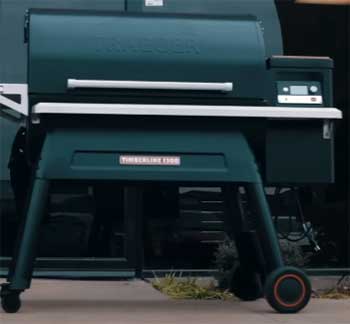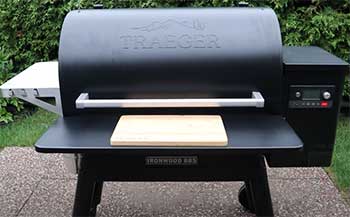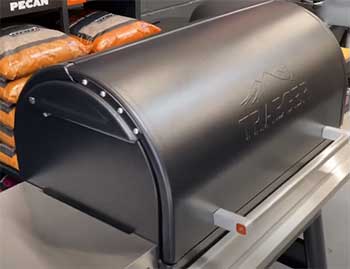With barbecue season in full swing, you may be looking to upgrade your grill game with a shiny new pellet grill. And if you’re set on Traeger, two of their most popular high-end models are the Timberline 1300 and Ironwood 885.
But with fairly similar capacities and both offering premium features, how do you choose between these two top-tier Traeger grills?
In this in-depth comparison, we’ll look at the similarities and differences between the Timberline 1300 and Ironwood 885 pellet grills. We’ll compare size, cooking space, temperature range, construction materials, smart grill capabilities, special features and more.
Read on to see how these two Traeger heavyweights stack up against each other!
A Brief Comparison Table
| Feature | Timberline 1300 | Ironwood 885 |
| Cooking Area | 1300 sq. in | 885 sq. in |
| Grill Surface | Stainless steel rods | Porcelain coated steel grates |
| Hopper Capacity | 24 lbs | 20 lbs |
| Temperature Range | 165°F to 500°F | 165°F to 500°F |
| Temperature Control | Pro D2 PID | D2 Direct Drive |
| Exterior | Double-walled stainless steel | Powder coated steel |
| Insulation | Fully insulated | Partial insulation |
| Interior Liner | Stainless steel | Porcelain coated steel |
| WiFi Controller | WiFIRE® | WiFi/D2 |
| TurboTemp | Yes | No |
| Meat Probes | 1 | 2 |
| Grease Management | No | Yes |
| Wheels | Locking casters | Hard rubber |
| Side Tables | Stainless steel | Standard |
| MSRP | $1799 | $1499 |
Overview and Specs

The Timberline and Ironwood series represent Traeger’s latest innovations in pellet grill technology.
As two of their most advanced (and expensive) models, both grills offer excellent performance and plenty of bells and whistles.
Here’s a quick overview of each grill’s core specs:
- Timberline 1300
- Cooking Area: 1,300 sq. in
- Hopper Capacity: 24 lbs
- Temperature Range: 165°F to 500°F
- Weight: 336 lbs
- Ironwood 885
- Cooking Area: 885 sq. in
- Hopper Capacity: 20 lbs
- Temperature Range: 165°F to 500°F
- Weight: 187 lbs
At first glance, the specs are broadly similar. Both grills offer ample cooking space – the Timberline 1300 just edges out the Ironwood with its extra 415 square inches. The temperature ranges match up, and both have a “keep warm” setting of 165°F.
However, there are also some notable differences. The Timberline 1300 has a larger pellet hopper, holding 24 pounds of fuel compared to 20 pounds in the Ironwood. And at 336 pounds fully assembled, the Timberline is almost twice as heavy as the 187-pound Ironwood.
So in terms of pure size and capacity, the Timberline 1300 has a slight advantage. But there’s more to the story than just the hard numbers.
Key Differences Between Timberline 1300 And Ironwood 885 Pellet Grills
Grill Surface and Cooking Area
Let’s take a closer look at one of the most important factors – cooking space.
The Timberline 1300 offers a total 1,300 square inches of grill area. This breaks down into a main cooking surface of 884 square inches, plus an upper rack with 416 square inches.
By comparison, the Ironwood 885 has, as the name suggests, 885 total square inches of cooking area. There’s 585 square inches on the main lower grill, and a 300 square inch upper rack.
So in reality, the extra space on the Timberline 1300 mainly comes from its larger upper rack. The lower grilling surfaces are roughly comparable at 884 vs 585 square inches.
Still, those extra 116 square inches on the upper Timberline rack can make a difference. It’ll allow you to smoke a couple more racks of ribs, or do some two-zone cooking with both direct and indirect heat.

Both grills give you plenty of room to cook multiple items at once.
From smoking brisket or ribs on the lower grate, to roasting corn, veggies or even pizzas on the upper rack, you’ll have flexibility with either Traeger.
One advantage of the Timberline’s grilling space is the unique slide and grill feature.
Part of the main grill pulls out to give easier access to the back area – making it simpler to baste, flip or add wood chips to your food. The Ironwood doesn’t offer this.
In terms of grill surface materials, the Ironwood uses Traeger’s standard porcelain coated steel grates. But the Timberline 1300 steps it up with stainless steel grilling rods. Stainless steel is lighter than porcelain coated steel and can provide more even heat distribution.
Temperature Range and Control
Good temperature precision and control are vital for successful barbecuing. You need a grill that can hold a steady temp for perfect low and slow smoking, while also hitting scorching temps for searing steaks or burgers.
Both the Timberline 1300 and Ironwood 885 have a wide temperature range from 165°F to 500°F. This gives exceptional flexibility whether you’re looking to bake pizza at 400°F+ or hold a delicate salmon fillet at 275°F.
For precision control, the Timberline uses Traeger’s Pro D2 Direct Drive system. The Pro D2 PID controller actively monitors temperature and adjusts the pellet feed rate to hold within +/- 15 degrees of your set point.
The Ironwood runs on Traeger’s earlier D2 Direct Drive drivetrain. It’s still digital and precise, capable of holding target temperatures within +/- 20 degrees. But the Pro D2 controller on the Timberline is a little more advanced.
In real world use though, both Traeger grills provide excellent temperature management. The Timberline may have slightly better temp stability, but either grill will maintain tight control for perfect smoky barbecue.
Grill Construction
Under the hood, there are some important differences in how these grills are put together. This affects their overall build quality, heat retention, and weather resistance:
Exterior Materials
- Timberline 1300: Double-walled stainless steel exterior
- Ironwood 885: Powder coated steel exterior
Insulation
- Timberline 1300: Fully insulated
- Ironwood 885: Partial insulation around the firepot
Interior Liner
- Timberline 1300: Stainless steel
- Ironwood 885: Porcelain coated steel
The Timberline clearly wins out on construction. Its double-walled stainless exterior is built for lifelong durability, while also helping retain heat better than the Ironwood’s powder coated shell.
Full insulation is another big advantage, allowing the Timberline to hold its temperature in windy or cold weather. And the stainless steel interior will resist rust and corrosion much better than the Ironwood’s coated steel liner.
Overall, the Timberline 1300 is the clear winner on build quality and weather resistance. Its sturdy construction and thick insulation really helps justify the higher price tag.
Hopper Capacity
Another difference between the Timberline and Ironwood is hopper capacity:
- Timberline 1300: 24 lbs
- Ironwood 885: 20 lbs
That extra 4 lbs of pellet storage is nice to have, letting you cook longer without a refill. But in reality, whether a 20 lb or 24 lb hopper is better comes down to your smoking habits.
For shorter cooks like burgers or chicken thighs, you likely won’t burn through more than a couple pounds of pellets anyway. And for super long smokes, you’ll still probably need to add more fuel at some point regardless.
So while the Timberline’s hopper holds more, don’t assume the Ironwood’s is too small. It’ll still give 12+ hours of continuous smoke time, covering most people’s needs. Pick based on total cooking area vs hopper size, not capacity alone.
Smart Grill Technology
Traeger basically invented the modern WiFi pellet grill, and both the Timberline and Ironwood represent their latest advancements in connected barbecue technology.
The Timberline controller features Traeger’s WiFIRE® technology, while the Ironwood has their earlier WiFi/D2 controller. Both allow you to connect your grill to home WiFi and control temperatures remotely from your phone.
Key connectivity features include:
- Temperature monitoring
- Remote adjustment
- Pellet alerts/monitoring
- Shut down and startup
- Voice control integration (with Alexa or Google Home)
Additionally, the Timberline 1300 boasts Traeger’s TurboTemp® technology for faster startup and recovery. The grill uses variable speed fans to rapidly heat up, meaning you can start cooking sooner.
Connected capabilities are excellent on both grills. But the Timberline’s WiFIRE® controller is more advanced, with additional features like a smoke level toggle and “Super Smoke” mode for extra wood flavor at low temps.
So if you love playing with tech gadgets while you grill, the Timberline has a slight tech edge. But the Ironwood still provides plenty of versatile WiFi functions.
Special Features and Extras
Aside from core performance, what other special features set the Timberline and Ironwood apart? Here are some of the extras each grill brings to the table:
Timberline 1300 Extras
- Stainless steel side shelf with integrated cutting board and hooks
- Stainless steel double-walled chimney
- Lockable caster wheels for easier mobility
- Under-grill cabinet storage
- Magnetic bamboo cutting board
- Internal meat probe
Ironwood 885 Extras
- Hard rubber caster wheels
- Side shelf with removable cutting board
- Storage cabinet with two drawers
- Internal meat probes (x2)
- Grease management system
Both grills come equipped with handy extras to enhance usability. The Timberline’s stainless steel side tables and locking wheels add durability and make maneuvering easier. Ironwood’s dual meat probes let you monitor two different internal temperatures at once.
Small perks like the under-grill cabinet storage on Timberline or the magnetic cutting board are great bonuses. And Ironwood’s grease management system helps reduce cleanup time.
For accessories and upgrades, Traeger offers a range of add-ons like insulation jackets, pellet sensors, grill covers and more that are compatible with both grills.
Overall, there’s no clear winner – the Timberline and Ironwood are evenly matched when it comes to useful special features.
Ease of Use
Traeger is loved by backyard pitmasters for good reason – their grills are incredibly easy to use right out of the box.
Setup is simple for both grills – expect a bit of assembly sweat getting the wheels, handle and chimney attached. Once built, you load the hopper with pellets, power on, select your temperature, and let the grill do the work.
The digital controllers make both grills a breeze to operate. Dial in your target temp and just monitor periodically. Adding more pellets or wood chips takes just seconds.
Traeger’s hopper cleanout systems also make maintenance simple. The Ironwood uses Traeger’s easy-empty hopper, while Timberline has their quick cleanout hatch – both work great to empty unused pellets.
And for truly effortless cooking, you can pair either grill with Traeger’s app and monitor everything from your phone. The technology really reduces any babysitting once your food is on the grill.
Overall, ease of use is excellent on both the Timberline 1300 and Ironwood 885. Novices and pros alike will find them simple to start cooking fantastic wood-fired food.
Cost Comparison
Being premium grills, neither the Timberline 1300 or Ironwood 885 are cheap options. But how do their price tags stack up?
Here are the MSRPs direct from Traeger:
- Timberline 1300: $1,799.99
- Ironwood 885: $1,499.99
As expected, the Timberline commands a higher price, coming in $300 more expensive. You’re paying a premium for features like the stainless steel exterior, TurboTemp engine, and extra insulation.
However, you can often find both grills for significantly less than MSRP from various retailers like Amazon, Ace Hardware or Walmart:

- Timberline 1300: $1,399 + free shipping (Amazon)
- Ironwood 885: $1,299 + free shipping (Walmart)
With holiday sales, clearance deals or bundle packages, the real-world prices end up much closer.
Overall value depends on whether the Timberline’s upgrades are worth an extra $100-200 to your needs.
No matter which you choose, opt for Traeger’s additional 3-year warranty if you want the best long-term protection.
And remember to account for pellets, rubs, sauces and other essential grilling accessories.
Timberline 1300 Or Ironwood 885: Which Should You Buy?
So when all is said and done, should you splurge on the flagship Timberline or save with the Ironwood? Here are a few closing thoughts:
- For superior construction and weather-proofing, the Timberline is worth the investment. Its stainless steel build and insulation really outmatch the Ironwood.
- If you grill year-round or in tough conditions, the Timberline’s sturdy exterior and insulation help justify the price.
- Ironwood gives you almost equal cooking space for less money. If your budget is tight, it’s hard to beat the value.
- Tech addicts may enjoy the WiFIRE® controller’s advanced features, but Ironwood still has excellent WiFi capabilities.
- For a few hundred dollars in savings, some grease management extras, and dual meat probes, Ironwood remains an excellent option.
Frequently Asked Questions (FAQ)
Overall, the Timberline 1300 is the better, higher-quality grill. It features superior stainless steel construction, extra insulation, and handy extras like the pull-out grill shelf. The Ironwood 885 is also an amazing grill, but the Timberline takes things up a notch.
Not at all – the Ironwood 885 is a great mid-sized grill option. With 885 total square inches of cooking space, it can easily handle 8-12 burgers or 2-3 racks of ribs. Unless you need to feed huge gatherings, the Ironwood offers ample grilling capacity for most families.
Yes, the Traeger Ironwood 885 sold at Costco is identical to the standard 885 model. Costco sometimes adds bonus accessories like extra pellets, rubs or a cover in their packages, but the grill itself is no different.
Yes, the Timberline 1300 features full insulation. It has a double-walled stainless exterior and thick insulation between the walls. This helps the Timberline maintain temperatures in cold weather or wind much better than less insulated grills.
Final Thoughts
In the end, you really can’t go wrong with either of these exceptional Traeger grills. If you can afford the Timberline 1300, the quality and construction are worth the upgrade. But the Ironwood 885 still performs incredibly well at a lower price point.
Whichever model suits both your barbecue needs and budget, you’ll be equipped to create mouthwatering smoked masterpieces all season long!
